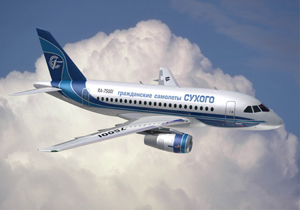 A new ballscrew made by Steinmeyer, manufacturer of ballscrew and nut assemblies, has been specified for the horizontal stabilizer trim actuator of a new regional jet to be officially launched at the Paris Air Show in June. A new ballscrew made by Steinmeyer, manufacturer of ballscrew and nut assemblies, has been specified for the horizontal stabilizer trim actuator of a new regional jet to be officially launched at the Paris Air Show in June.
The horizontal trim actuator has been developed and produced by Liebherr-Aerospace Lindenberg GmbH, Germany, responsible for the complete Fly-by-Wire Flight Control System of the new regional jet.
The Sukhoi SuperJet 100, produced by Russian aerospace firm Sukhoi Civil Aircraft Company, is a modern, fly-by-wire regional jet in the 75- to 95-seat category. It is still undergoing flight tests and the first commercial deliveries are expected later this year.
|
An aeroplane must be in balance longitudinally in order to fly. This means that the net effect of all the forces acting on the aeroplane produces no overall pitching moment about the centre of gravity. Without a horizontal stabilizer there would be only one combination of speed and centre of gravity position where this requirement was met. The horizontal stabilizer provides a balancing force to maintain equilibrium for different speeds and centre of gravity positions. The new ballscrew is part of an actuator that moves the horizontal tail surface of the plane up and down to accommodate the changing centre of gravity.
Alex Beck, international sales manager and co-owner of Steinmeyer says: 'Breaking into the aerospace component market has been a natural progression from the new product development standpoint. We make ballscrews in all sizes from miniature to large ballscrews suitable for high load applications. This design and engineering expertise, we were sure, was going to make it possible to design ballscrews for aerospace applications.
'Precision is key in ballscrew manufacturing. This particular ballscrew was going to be part of a flight critical application and there is no room for error.' Steinmeyer has traditionally made all tools and prototypes in-house, an experience which was going to prove very useful.
The ability to withstand stress is an important factor in the design of flight critical components. All structural parts need to be tested under maximum stress levels. For that purpose design engineers at Steinmeyer simulated different load scenarios. An example is the runaway check. During this a malfunction of an electronic or electrical part causes the actuator to run against its end stop at full speed and full motor torque. Another scenario could be a gear box jamming leaving all parts locked under inertia. The components of the actuator have to withstand these load conditions without causing the actuator to fail. Should for whatever reason the actuator sustain damage during flight, or should wear to the mechanical parts excess certain limits, a sensor triggers an alarm. The part can then be identified and replaced during an inspection, rather than operating the aircraft with the help of the backup system for any length of time.
All parts of the horizontal stabilizer trim actuator were modelled in 3D using SolidWorks software. Various load conditions for all structural parts were analysed with Finite Element Method (FEM) stress analysis and the design adjusted accordingly where necessary, especially where safety was concerned. Every time the design was changed, tests were carried out under a range of load conditions. The ballscrew in the actuator has a special fail-safe feature causing an alarm to be triggered if the load limit is exceeded only once. The design was only finalised when the achieved safety margin was satisfactory.
The ballscrew is designed to operate 60,000 flight cycles safely and accurately. It is made from Cronidur30® steel, a stainless steel specifically developed for aerospace applications. To make the component fit for the flight critical application special care had to be taken during the manufacturing process which involves the grinding of the steel parts and can lead to grinder burn with dangerous consequences.
Grinder burn is caused by excessive heat generation during the grinding of hardened steel parts. This induces tensile stresses into the material which can lead to micro cracks and subsequent failure of the part. Although sometimes a blackened surface is an obvious sign of grinder burn being present, more often than not there is no visible sign.
Conventional tests for the detection of grinder burn destroy the part. Steinmeyer, in cooperation with Liebherr-Aerospace Lindenberg GmbH, has developed a non-destructive method to detect grinder burn using the Barkhausen[1] <#_ftn1> effect. It involves sending an alternating magnetic field through the part. Changes in the magnetic noise indicate stress conditions in the material. In order to interpret the results correctly, each new part and the slightest design change require a completely new calibration of the sensor. This is a complicated and time consuming process, but once calibrated the Barkhausen noise inspection allows complete, reliable and quick scanning of each ballscrew.
The horizontal stabilizer trim actuator is only one aerospace application for Steinmeyer ballscrews. The company has set up a special aerospace division with its own dedicated design engineers, assembly and inspection staff. Work on a number of prototypes, to be used in civil and military aerospace applications, is currently under way. |



 A new
A new